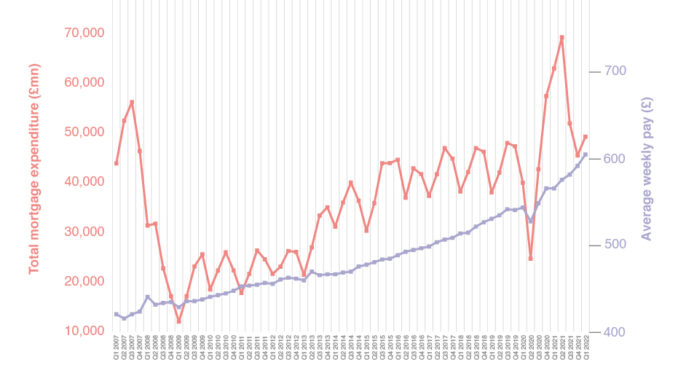
The Bank of England raised interest rates in March from 4% to 4.25%. The 0.25 percentage point increase marks the 11th rise since December 2021 when Bank rate stood at just 0.1%. It puts Bank rate at its highest level since 2008 and has applied further upward pressure on the cost of borrowing.
The next Bank rate decision will be announced on 11 May 2023.
Volatility and uncertainty
Mortgage rates have been settling since costs rocketed after last September’s mini-Budget which triggered market uncertainty and sent the pound crashing to historic lows. Major lenders including NatWest, Barclays, Halifax and Virgin Money all pulled deals and brought them back to the market at higher prices.
Mortgages costs have been continuing to come down from their peak, potentially settling at around their current levels.
Average and best costs of popular deals
According to our mortgage partner, Better.co.uk, the average cost of a two-year fixed rate deal stands at 4.54% today. Average costs of a three-year and five-year fixes stand at 4.46% and 4.22% respectively. This compares to highs of more than 6.50% back in October 2022.
Better.co.uk says the most competitive deals are 3.78% for a two-year fix, 4.08% for a three-year, and 3.79% for a five-year. The best 10-year fixed rate deal today is 4.05%.
The average two-year tracker rate today stands at 4.63%, compared to the leading deal of its kind which is priced at 4.39%.
The typical standard variable rate (SVR) has rocketed to 7.26%, according to Better.co.uk, reflecting the recent Bank Rate increase. This compares to 4.30% in March 2022 and is the highest SVR seen since 2008, suggesting lenders may be nervous about the continued upward trajectory of interest rates generally.
At the start of April there were 5,146 residential mortgage deals on the market, according to Moneyfacts. The number has climbed from 4,372 since the start last month, and is nearing the 5,300 recorded in December 2021 before interest rates began to climb.
The number of available mortgages had plummeted to around 2,560 following last Autumn’s mini-Budget.
Interest rates and mortgages
So what do rising interest rates mean for the cost of mortgages so far?
The estimated two million homeowners on variable rate deals, such as base rate trackers, will see an almost immediate rise in their monthly repayments following the latest Bank rate rise to 4.25%. As an example, a tracker rate rising from 4.5% to 4.75% costs around an extra £31 a month on a £200,000 loan taken over 25 years.
Those on fixed-rate deals, where the interest rate is locked in for, say, two or five years, won’t see any difference in their monthly payments. But when the deal comes to an end, mortgages available are likely to be more expensive.
You can work out the monthly cost of a mortgage against various interest rates with our Mortgage Calculator.
House prices and Stamp Duty
The latest house price index from Nationwide Building Society shows house prices fell by 3.3% in the 12 months to March, with prices down 0.8% month-on-month. It’s the seventh monthly fall in a row, and it leaves prices 4.6% below their peak, recorded in August 2022.
Property portal Rightmove says that the average cost of a home being listed for sale in April now stands at £366,247, which is 1.7% higher than last year and just 0.2% up on last month.
Stamp Duty cuts announced in last Autumn’s mini-Budget raised the nil-rate band on the purchase of a property from £125,000 to £250,000. While u-turns were made on the other tax breaks announced under former Prime Minister Liz Truss, this one remained in place.
Why are interest rates rising?
The Bank’s MPC uses interest hikes as a means of cooling the economy and taming rising inflation. The Consumer Prices Index (CPI) measure of inflation fell to 10.1% in the 12 months to March – higher than the 9.8% expected by analysts – due largely to rising costs in the food sector.
Inflation peaked in October at 11.1% but had since largely been falling. The government’s inflation target for the Bank of England is set at 2%.
One of the main longer-term drivers behind rising inflation is the cost of energy. Since 1 April, 2023 the energy price cap, as set by regulator Ofgem has been pegged at £3,280. The cost refers to an annual bill for a dual fuel household paying by direct debit based on typical consumption.
However, the government’s own Energy Price Guarantee (EPG) which was implemented to protect households from rocketing energy costs, applies instead. Currently, the EPG is set at £2,500 a year.
The EPG was originally scheduled to rise to £3,000 from 1 April, but the government confirmed in the lead-up to its March Budget that the £2,500 limit will apply for a further three months, from April until the end of June.
What mortgage deals are available?
With upwardly-mobile Bank rates, keeping track of mortgage costs is challenging – especially when rates change, and deals can be pulled, on a daily basis.
One simple way is use our mortgage tables, powered by Better.co.uk.
To find out what deals are available at today’s rates for the kind of mortgage you’re after, you’ll need to enter your personal criteria into the table below. Here’s what to do:
- Select whether the mortgage is to fund a house purchase or if it’s a remortgage for an existing property
- Enter the property value and the mortgage amount you require. This will automatically generate a percentage which is known as your ‘loan to value’. The lower your loan to value, the cheaper the mortgage rates available
- Tick the relevant box if it’s a buy-to-let or interest-only mortgage (you’ll need a repayment strategy in place for these deals), or if you’re looking for a mortgage to fund a shared ownership property
- Finally, filter your search by the type of mortgage you want, for example a two- or five-year fix or tracker. The filter is set to a complete mortgage term of 25 years but you can change this if required.
What else do I need to know?
Mortgage deals offering the cheapest rates usually come with fees attached. You can opt to pay these upfront or add them to the loan. To factor in the cost of the fee, order your the results by ‘initial period cost’ (in the ‘Sorted by’ dropdown).
Alternatively, you can order results by initial rate, lowest fee or monthly repayment – even by the lender’s ‘follow on’ rate that the deal will revert to at the end of the term.
The very cheapest are reserved for bigger deposit amounts, usually of 60% of the property value or more. And, in all cases, you will need a sufficient income and clean credit history to be accepted for a mortgage.
If you want to see what your monthly mortgage payments might look like in different scenarios while overlaid with household bills, our Mortgage Calculator will crunch the numbers.
When can I start a remortgage?
Once issued, mortgage offers tend to be valid for six months, although a handful of lenders such as Skipton Building Society honour offers for up to 12 months. If you are looking to remortgage your current home, this means you can lock in a rate today – at no cost and with no strings attached.
Source: www.forbes.com
ENB
Sandstone Group



